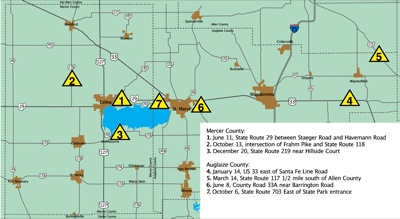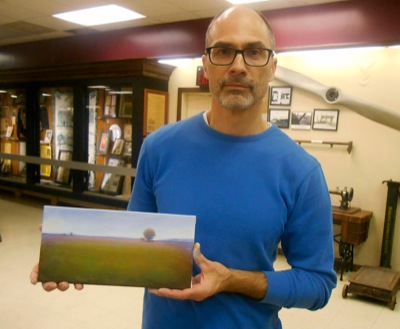Thursday, January 5th, 2017
Possible drawing sought in bones case
DNA sent to firm to obtain more details
By William Kincaid
CELINA - Mercer County Sheriff's Office personnel have sent a DNA profile extracted from human bones discovered a year ago outside of Celina to a private company to obtain a more detailed profile of the homicide victim.
Sheriff Jeff Grey, talking to Grand Lake Rotarians this morning, said his office had sent the DNA to the company in December. The results of its examination, including a possible composite drawing of the victim, should arrive in March or April, he said.
His office has set aside $7,000 for the work.
University of North Texas investigators last year extracted a full DNA profile and determined the bone samples had come from a male, confirming an earlier finding by The Ohio Bureau of Criminal Investigation's London lab.
The bones are believed to be those of a man of unknown race, ranging in age from 20 to 35 years old and between 5 feet 7 inches and 6 feet 1 inch tall, who went missing in 2015, based on an autopsy completed by forensic anthropologist Dr. Elizabeth Murray of Mount St. Joseph University in Cincinnati.
Grey said the private company may be able to provide the race, eye color, hair color and a more precise height of the victim. That type of information is not furnished by government-aligned laboratories because it's politically incorrect and "might offend somebody," Grey noted.
"That's very frustrating when you're trying to investigate a case," he said. "It's very important that we know whether this person is white, black, Latino. I mean, gee, that kind of narrows down who we're looking for." But Grey didn't mince words about how the man had died.
"Somebody killed that person, and we can prove that somebody killed that person," he said. "I just don't know who killed them, and I don't know who they are."
Not wanting to jeopardize the integrity of the case, he gave no specific details.
Grey said he believes the bones, which were found on state-owned wooded land east of U.S. 127 on Grand Lake in January 2016, had been put there just two months before the find.
Investigators had initially looked at all of 2015 because they didn't want to limit the scope of missing persons searches, he said.
"Whoever it is could have went missing ... a lot earlier and not killed until later on," Grey said.
The victim likely isn't from anywhere near the area, he noted.
"We have went out a 250-mile radius with the description that we have, and we're not finding anybody that's missing," he said. "We do believe that when the person was dumped there, they weren't decomposed at the time."
The DNA profile has been loaded into the FBI's Combined DNA Index System's database and The National Institute of Justice's National Missing and Unidentified Persons System, a national repository and resource center for cases involving missing people and unidentified bodies.
"If the person was arrested someplace for a felony in a state that takes DNA, then we would get a hit," he said.
However, DNA policies vary from state to state. For instance, Ohio collects DNA from anyone arrested for a felony while Indiana does so only from people convicted of a felony, Grey said.
"That could be somebody's dad," Grey said of the victim. "There's a family out there someplace that's looking for this person."
A woman walking her dog Jan. 3, 2016, near state park land reportedly found several bones and notified the sheriff's office. The skeletal remains were lying in plain view southeast of the mouth of Coldwater Creek, Grey had said.
The number or types of bones recovered were never disclosed, but Grey had noted that investigators do not have a complete skeleton.
Initially, the bones were thought to belong to deer because people sometimes dump such carcasses in the area.
However, some bones raised suspicions, so officials took them to the Montgomery County Coroner's Office where doctors determined they very likely were human.

